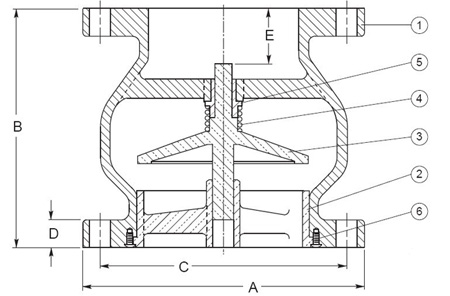A no slam check valve is also known as a non-slam check valve or silent check valve designed to prevent water hammering or slamming in a piping system. Water hammering is caused by surge pressure which occurs when the water-flow is stopped or forcefully changes the direction in a piping system. Therefore, it causes a shockwave in pipes that damage the entire system resulting in broken pipes or damaged joints.
A no slam check valve therefore, controls the smooth closing speed of a valve to reduce the shock of water hammering instead of slamming shut.
In this blog post, we will discuss the features, uses, applications, manufacturing procedure, and quality checking process of no slam check valves.
Types of Non Slam Check Valve:
A non slam check valve comes in a variety of choices suitable for each purpose. The most common types include: swing check valve, tilting disc check valve, and dual plate check valve.
Features of a No Slam Check Valve:
The no slam check valve has many features and benefits to maintain a durable piping system. Though it has a very basic operation to smoothly close the valve to stop the flow of water in the pipe, the surge pressure it reduces is very notable.
A good quality no slam check valve is known to have following features:
Water Shut Speed: A good quality non slam check valve will gradually close the water flow instead of slamming shut irrespective of water pressure in a system.
Low maintenance: It requires very little maintenance,as designed to operate smoothly and reliably for long periods of time. The maintenance mostly include: insulating joints, installing new rubber seals and applying rust resistant coating.
High durability: These valves are designed to withstand high pressure and temperature to reduce water hammering. Thus, they are made highly durable to work for long periods of time.
Wide range of sizes: No slam check valves are available in a wide range of sizes, making them suitable for use in both small and large piping systems.
Uses and Applications of No Slam Check Valve
A no slam check valve is a versatile valve that is designed to be used in a wide range of applications where the piping system is complex and bears high pressure and temperature. It may be widely used in the following system:
Water supply systems: These valves are used in water supply systems, water treatment plants, and water storage systems to prevent costly damage to water lines.
Sewage systems: A no slam check valve can be installed between the sewage system main lines that prevents water backflow while protecting the piping system from damage or tear.
Chemical processing plants: The valves are used in chemical processing, similar to water supply systems to prevent backflow and reduce the water shut slamming.
Industrial Manufacturing of No Slam Check Valve
The manufacturing process of no slam check valves involves several steps, including:
Body making by casting and molding.
This is the very first step to manufacture a no slam check valve by using casting and molding methods. The valve body is first designed for casting, and then a mold of sand or metal is created to replicate the required shape and dimensions of the valve.
The molten metal is poured into the mold and allowed to cool. Once cooled, the mold is removed and the desired body shape is ready in metal form which is sent to the next stage.
Refining and machining
In this stage the metal valve body is treated with machines for refining and buffing. The refining machines smooths the metal body surface, and equals the dimensions of the valve body after casting.
Modern machines like lathes and milling machines are used to remove excess material and create the required features.
The fine quality of a valve is determined in this process.
Make it assemble
In this process the internal components of the valve, such as the disc, stem, and spring are fixed into the valve body. Each component is carefully installed to make sure a valve will function properly, without any leakage.
Testing
Before sending a valve to a warehouse for shipment a product is tested to ensure that it operates smoothly and reliably meets the required performance specifications. Testing involves a range of tests, including pressure testing, leak testing, and functional testing. Once the valve has passed all tests, it is ready to be shipped.

Quality Checking Process of No Slam Check Valve
The quality checking process of no slam check valve is done in the production unit. Each valve manufacturing company might have unique steps but not limited to these:
Visual inspection: When the valves are carried to the assembly process using conveyor belt a visual quality inspector will inspect each non slam check valve visually for defects or irregularities in the casting or machining process.
Performance testing: A valve is tested on high pressure and temperature determining if it operates smoothly to shut the valve. A product can be rejected or passed during this process which is carried out using computers..
Quality testing: It is an overall test that is done manually to compare machine generated results.Here, the quality of a material, internal components and custom quality metrics for special requirements are noted.
Conclusion
No slam check valves are an important component in piping systems that prevent water hammer and protect the piping system and equipment from damage. They are designed with a mechanism that controls the closing speed of the valve, ensuring that it closes gradually and smoothly instead of slamming shut.
No slam check valves are used in a wide range of applications, including water supply systems, sewage systems, HVAC systems, and chemical processing plants. The manufacturing process of no slam check valves involves several steps, including casting, machining, assembly, and testing, while the quality checking process involves visual inspection


